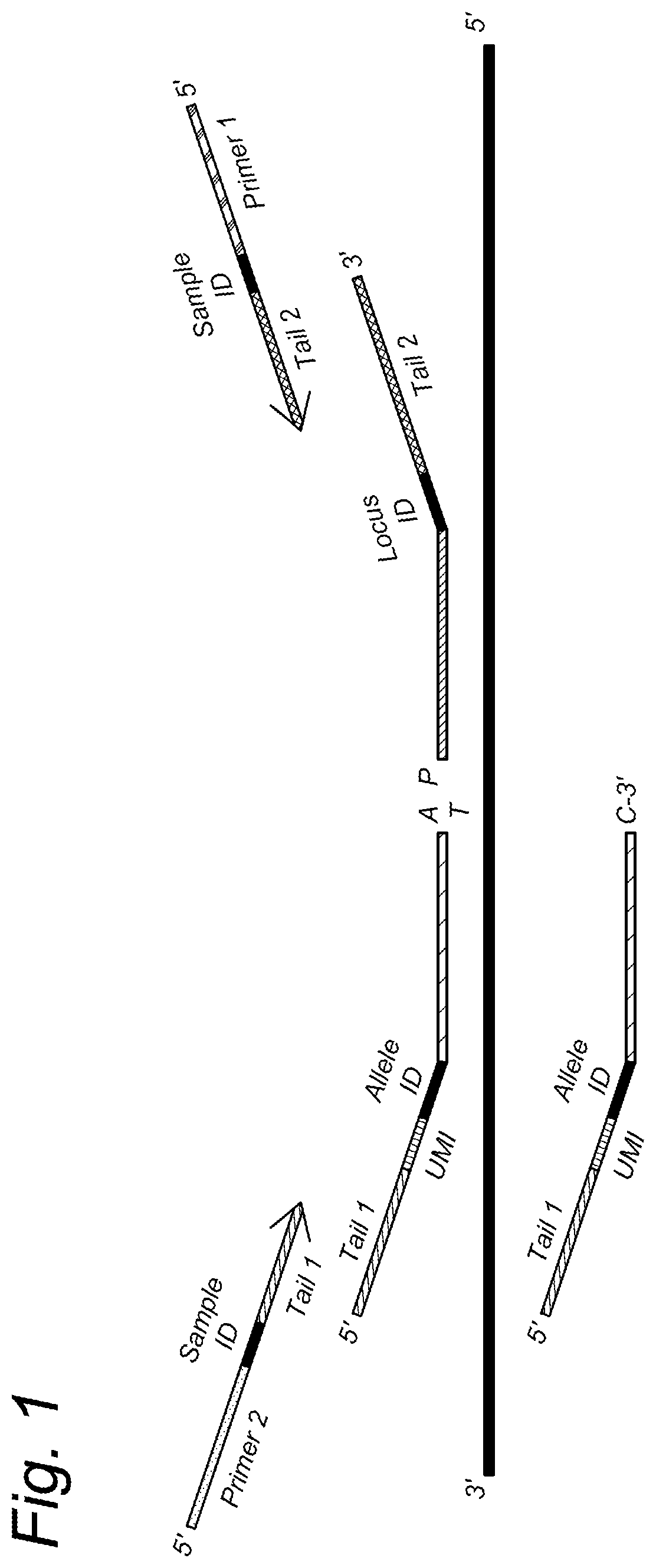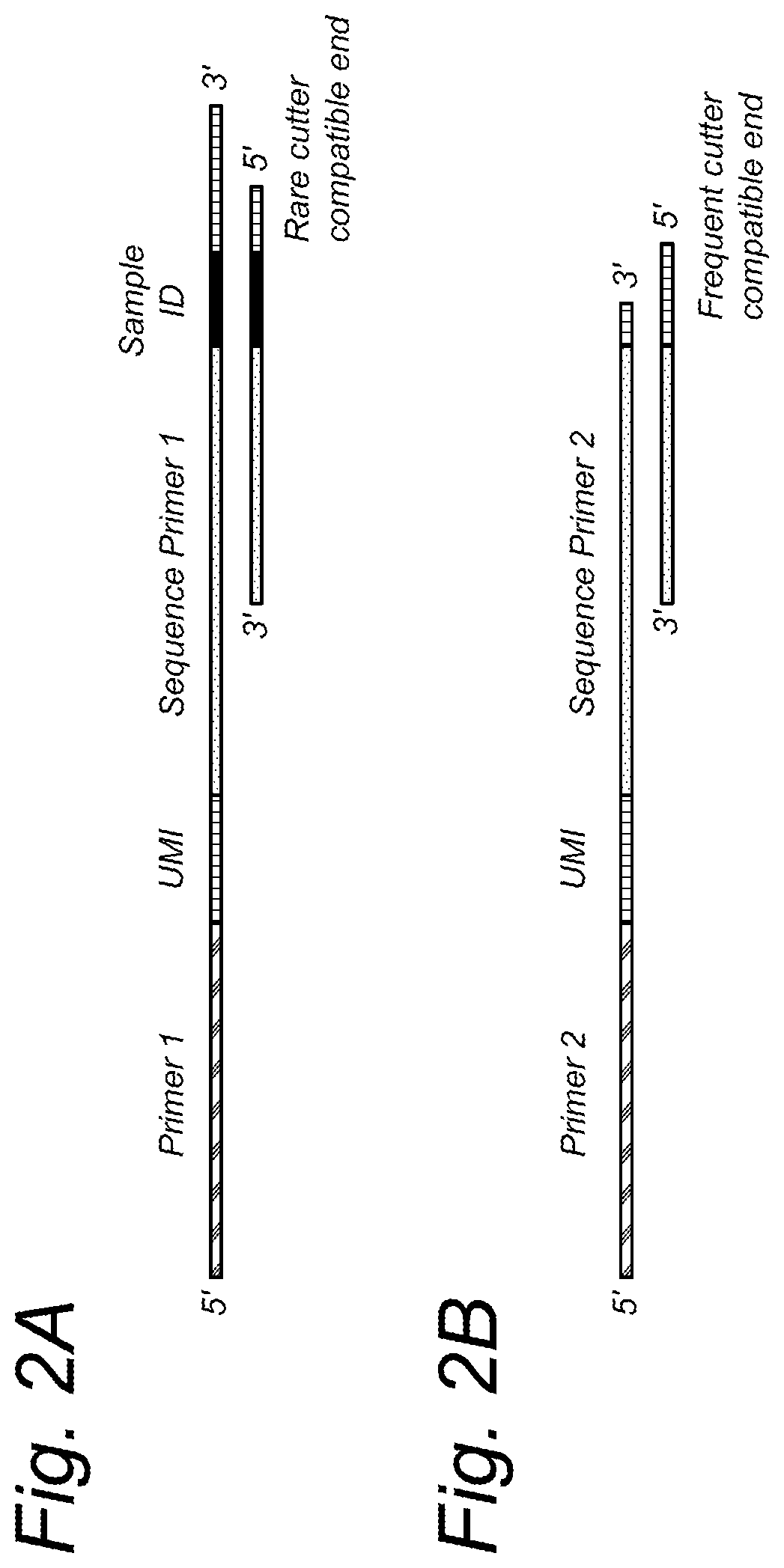Genotyping of polyploids
a polyploid gene and polyploid technology, applied in the field of molecular biology, can solve the problems of inaccurate genotype assignment, complicated situation, cumbersomeness, etc., and achieve the effect of high coverage expression profiling
- Summary
- Abstract
- Description
- Claims
- Application Information
AI Technical Summary
Benefits of technology
Problems solved by technology
Method used
Image
Examples
example 1
[0247]UMIs can be implemented in oligonucleotide ligation (OLA) / genotyping assays for polyploid cells e.g. through the addition of random DNA sequences just before and / or after the Allele Specific Identifier present in the Allele Specific probe. Furthermore, addition of UMIs is possible in the Locus Specific Probe or in both probes. An example of the probe design, including the UMI in the Allele Specific probe, is outlined in FIG. 1.
example 2
[0248]Application of UMIs in next-generation sequencing and genotyping of polyploid cells can be implemented through addition of UMIs in e.g. the rare cutter adapter sequence used for sequence-based genotyping. An outline of a rare cutter adapter including a UMI is presented in FIG. 2. UMIs might also be added to the P7 adapter, e.g. if a non-selective amplification is used after adapter ligation. For this, the P7 adapter can be designed to comprise the UMI and a sequencing primer sequence, followed by the overhang specific for the restriction endonuclease used. Such adapter is compatible with paired end sequencing of the amplification products.
example 3
[0249]Validation of Oligonucleotide Probes with UMIs
[0250]An experiment was performed using UMI-comprising oligonucleotide ligation probes. Analysis was subsequently performed with and without use of the UMI information.
[0251]Oligonucleotides were designed to detect 326 different SNPs in the maize genome (Zea mays), each having 2 alleles (i.e. 326-plex), in an OLA assay. The probes were produced and used for genotyping different genomic maize DNA samples. Two sets of homozygous diploid germplasm lines were mixed in varying amounts to mimic tetraploid genomic samples. Set 1 consisted of germplasm lines PH207 (P1) and CO125 (P2), whereas set 2 consisted of the germplasm lines B73 (P3) and Mo17 (P4). These germplasm lines are available at U.S. National Plant Germplasm System (https: / / npgsweb.ars-grin.gov / gringlobal / search.aspx?). The ratios in which DNA of the germplasm lines were mixed is shown in table 1 and 2.
TABLE 1P1 and P2 mixing ratiosRATIOP1P2ng P1ng P24010003175252250501325750...
PUM
| Property | Measurement | Unit |
|---|---|---|
| volume | aaaaa | aaaaa |
| volume | aaaaa | aaaaa |
| volume | aaaaa | aaaaa |
Abstract
Description
Claims
Application Information
 Login to View More
Login to View More - R&D
- Intellectual Property
- Life Sciences
- Materials
- Tech Scout
- Unparalleled Data Quality
- Higher Quality Content
- 60% Fewer Hallucinations
Browse by: Latest US Patents, China's latest patents, Technical Efficacy Thesaurus, Application Domain, Technology Topic, Popular Technical Reports.
© 2025 PatSnap. All rights reserved.Legal|Privacy policy|Modern Slavery Act Transparency Statement|Sitemap|About US| Contact US: help@patsnap.com



